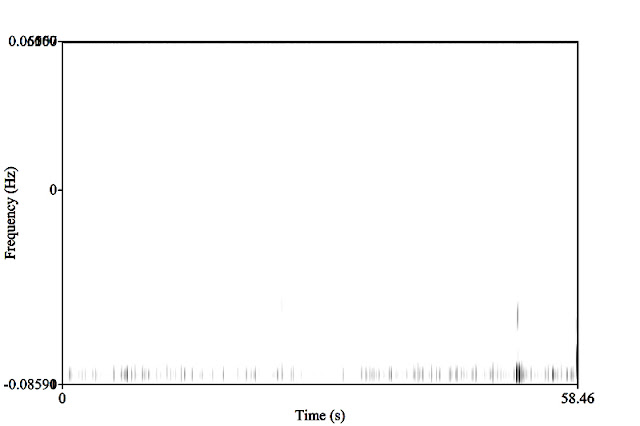Is N2B big enough?
This is probably the number one question we’ve fielded this week. A lot of people have expressed concerns that N2B isn’t big enough for the eagles. However, the nest was already roughly 4.5 feet high by 5 feet wide when we left it in August – big enough for Neil to sit comfortably inside it! The eagles have built it up substantially since then, as the image below shows.

Image courtesy Sherri Elliott. The red line by Neil’s head shows the location of the diamond shaped bark on August 20th.
So why does the nest look small to us? Camera angles can easily fool the eye. The nest is foreshortened by the angle of our camera and appears smaller than it actually is. Wikipedia defines foreshortening as “The visual effect or optical illusion that causes an object or distance to appear shorter (or smaller) than it actually is because it is angled toward the viewer.” The nest is also not scaled evenly, further distorting its true size and shape. If you would like to take a look at more perspective illusions, follow this link: https://youtu.be/Pl9Npmtj_18. You might be surprised at how easy it is to fool the eye!
Is the nest smaller than N1 and N2? It could be…but remember, we haven’t seen a nest in year zero before. We watched N2 from the ground in 2012/2013 courtesy Jim Womeldorf, and we didn’t film live from N1 until its third year. We don’t really have an adequate basis for a first-year comparison.
Is the nest too small? Mom is about three feet long, while slightly smaller Dad is about 2.5 to 2.6 feet long. Both of them are able to comfortably fit into the nest and incubate eggs, even if they can’t back their tails up to the tree limb. The nest has plenty of room now and it should only get bigger as they haul in more branches and grasses. Nest work is never done!
Why didn’t Mom and Dad put the egg cup in the center of the nest?
We can only speculate about the location they chose, but we suspect that the tree limb provides them with some protection from wind, weather, and bright sunlight. If Mom and Dad sit between the eaglets and the rails, as we think they will do, the eaglets will have a lot of room when they begin to explore the nest. Looking at the nest cup now – that not-so little egg nestled in a deep pile of fluffy grass – I think they couldn’t have done a better job building it.
Why are Mom and Dad spending so much time off the egg?
This has dovetailed with another question: do eagles delay incubation? Peregrine falcons don’t begin full incubation until after the third egg is laid in a four-egg clutch, but bald eagles begin incubating immediately because they usually lay eggs (at least in this part of the country) in weather that is at or well-below freezing (32F). If they didn’t incubate, the eggs would freeze and die. It is pretty well-accepted that bald eagles don’t delay incubation because they can’t.
Having said that, the weather is extremely warm this year and egg number one is still very early in embryonic development. Mom and Dad don’t need to incubate it constantly to keep it from freezing and Mom may not yet be deep in what Bob used to call the ‘incubation doldrums’. Eagles are relatively intelligent birds with very plastic behaviors, so it makes sense that they might spend less time on a newly-laid first egg in warm weather, even if they don’t delay incubation like peregrine falcons do.
It also helps to remember that 2014 and 2015 were both much colder and snowier than 2016 (knock on wood). In 2014, Mom laid her second egg in wind chills reaching -50F and we really didn’t see much of the eggs that year at all! While eagles are well-adapted to cold weather, I hope it stays on the warmer side this spring.
When will the next egg or eggs be laid?
If history is any guide, Mom will lay the next egg this afternoon or evening (February 21), and the third, if there is one, might come on Thursday, February 25. Despite what we see in Decorah and at Fort St. Vrain, three-egg clutches aren’t especially common. The breakdown looks like this, although the study cautions that results could change over time:
- 79% of clutches have two eggs
- 17% of clutches have one egg
- 4% of clutches have three eggs
When will the eggs start to hatch?
Bald eagle eggs hatch 35-37 days after they are laid, so hatch could start as early as March 25. However, I’m going to go with a longer forecast given that the first egg started hatch last year on March 27! Look for Mom and Dad to start vocalizing and chirping at the eggs as they go through the process of hatching. Altricial birds hatch blind, so vocalizing is an important part of the filial imprinting process – and a lovely thing to hear!
Read this blog for more information on embryonic development and hatching:
http://raptorresource.blogspot.com/2012/03/we-are-getting-lot-of-questions-about.html.
This blog was written 63 hours from lay time, so D24’s legs should just be beginning to form!
Bonus spectrogram
Mom chirps as she laid egg #24, which can be seen and heard here:
https://youtu.be/LuzWcIrfzFg

I’m not real happy with this spectrogram because there was a lot of noise versus signal, but her soft chirps can still be seen.
 The Raptor Resource Project
The Raptor Resource Project The Raptor Resource Project
The Raptor Resource Project